The Snapdragon 865 Performance Preview: Setting the Stage for Flagship Android 2020
by Andrei Frumusanu on December 16, 2019 7:30 AM EST- Posted in
- Mobile
- Qualcomm
- Smartphones
- 5G
- Cortex A77
- Snapdragon 865

Earlier this month we had the pleasure to attend Qualcomm’s Maui launch event of the new Snapdragon 865 and 765 mobile platforms. The new chipsets promise to bring a lot of new upgrades in terms of performance and features, and undoubtedly will be the silicon upon which the vast majority of 2020 flagship devices will base their designs on. We’ve covered the new improvements and changes of the new chipset in our dedicated launch article, so be sure to read that piece if you’re not yet familiar with the Snapdragon 865.
As has seemingly become a tradition with Qualcomm, following the launch event we’ve been given the opportunity to have some hands-on time with the company’s reference devices, and had the chance to run the phones through our benchmark suite. The QRD865 is a reference phone made by Qualcomm and integrates the new flagship chip. The device offers insight into what we should be expecting from commercial devices in 2020, and today’s piece particularly focuses on the performance improvements of the new generation.
- Qualcomm Announces Snapdragon 865 and 765(G): 5G For All in 2020, All The Details
- Qualcomm Windows on Snapdragon: New 7c & 8c SoCs for sub-$800 Laptops
- Quick Bytes: Qualcomm’s Dynamic Spectrum Sharing Demo with 5G and 4G
- Quick Bytes: Qualcomm’s Prediction of 1.4 Billion 5G Smartphones by 2022
- Qualcomm Snapdragon Tech Summit Live Blog: Day One
- Qualcomm Snapdragon Tech Summit Live Blog Day Two: All About Mobile
- Qualcomm Snapdragon Tech Summit Day 3 Live Blog: ACPC and XR
A quick recap of the Snapdragon 865 if you haven’t read the more thorough examination of the changes:
| Qualcomm Snapdragon Flagship SoCs 2019-2020 | |||
| SoC |
Snapdragon 865 |
Snapdragon 855 | |
| CPU | 1x Cortex A77 @ 2.84GHz 1x512KB pL2 3x Cortex A77 @ 2.42GHz 3x256KB pL2 4x Cortex A55 @ 1.80GHz 4x128KB pL2 4MB sL3 @ ?MHz |
1x Kryo 485 Gold (A76 derivative) @ 2.84GHz 1x512KB pL2 3x Kryo 485 Gold (A76 derivative) @ 2.42GHz 3x256KB pL2 4x Kryo 485 Silver (A55 derivative) @ 1.80GHz 4x128KB pL2 2MB sL3 @ 1612MHz |
|
| GPU | Adreno 650 @ 587 MHz +25% perf +50% ALUs +50% pixel/clock +0% texels/clock |
Adreno 640 @ 585 MHz |
|
| DSP / NPU | Hexagon 698 15 TOPS AI (Total CPU+GPU+HVX+Tensor) |
Hexagon 690 7 TOPS AI (Total CPU+GPU+HVX+Tensor) |
|
| Memory Controller |
4x 16-bit CH @ 2133MHz LPDDR4X / 33.4GB/s or @ 2750MHz LPDDR5 / 44.0GB/s 3MB system level cache |
4x 16-bit CH @ 1866MHz LPDDR4X 29.9GB/s 3MB system level cache |
|
| ISP/Camera | Dual 14-bit Spectra 480 ISP 1x 200MP 64MP ZSL or 2x 25MP ZSL 4K video & 64MP burst capture |
Dual 14-bit Spectra 380 ISP 1x 192MP 1x 48MP ZSL or 2x 22MP ZSL |
|
| Encode/ Decode |
8K30 / 4K120 10-bit H.265 Dolby Vision, HDR10+, HDR10, HLG 720p960 infinite recording |
4K60 10-bit H.265 HDR10, HDR10+, HLG 720p480 |
|
| Integrated Modem | none (Paired with external X55 only) (LTE Category 24/22) DL = 2500 Mbps 7x20MHz CA, 1024-QAM UL = 316 Mbps 3x20MHz CA, 256-QAM (5G NR Sub-6 + mmWave) DL = 7000 Mbps UL = 3000 Mbps |
Snapdragon X24 LTE (Category 20) DL = 2000Mbps 7x20MHz CA, 256-QAM, 4x4 UL = 316Mbps 3x20MHz CA, 256-QAM |
|
| Mfc. Process | TSMC 7nm (N7P) |
TSMC 7nm (N7) |
|
The Snapdragon 865 is a successor to the Snapdragon 855 last year, and thus represents Qualcomm’s latest flagship chipset offering the newest IP and technologies. On the CPU side, Qualcomm has integrated Arm’s newest Cortex-A77 CPU cores, replacing the A76-based IP from last year. This year Qualcomm has decided against requesting any microarchitectural changes to the IP, so unlike the semi-custom Kryo 485 / A76-based CPUs which had some differing aspects to the design, the new A77 in the Snapdragon 865 represents the default IP configuration that Arm offers.
Clock frequencies and core cache configurations haven’t changed this year – there’s still a single “Prime” A77 CPU core with 512KB cache running at a higher 2.84GHz and three “Performance” or “Gold” cores with reduced 256KB caches at a lower 2.42GHz. The four little cores remain A55s, and also the same cache configuration as well as the 1.8GHz clock. The L3 cache of the CPU cluster has been doubled from 2 to 4MB. In general, Qualcomm’s advertised 25% performance uplift on the CPU side solely comes from the IPC increases of the new A77 cores.
The GPU this year features an updates Adreno 650 design which increases ALU and pixel rendering units by 50%. The end-result in terms of performance is a promised 25% upgrade – it’s likely that the company is running the new block at a lower frequency than what we’ve seen on the Snapdragon 855, although we won’t be able to confirm this until we have access to commercial devices early next year.
A big performance upgrade on the new chip is the quadrupling of the processing power of the new Tensor cores in the Hexagon 698. Qualcomm advertises 15 TOPS throughput for all computing blocks on the SoC and we estimate that the new Tensor cores roughly represent 10 TOPS out of that figure.
In general, the Snapdragon 865 promises to be a very versatile chip and comes with a lot of new improvements – particularly 5G connectivity and new camera capabilities are promised to be the key features of the new SoC. Today’s focus lies solely on the performance of the chip, so let’s move on to our first test results and analysis.
New Memory Controllers & LPDDR5: A Big Improvement
One of the larger changes in the SoC this generation was the integration of a new hybrid LPDDR5 and LPDDR4X memory controller. On the QRD865 device we’ve tested the chip was naturally equipped with the new LP5 standard. Qualcomm was actually downplaying the importance of LP5 itself: the new standard does bring higher memory speeds providing better bandwidth, however latency should be the same, and power efficiency benefits, while there, shouldn’t be overplayed. Nevertheless, Qualcomm did claim they focused more on improving their memory controllers, and this year we’re finally seeing the new chip address some of the weaknesses exhibited by the past two generations; memory latency.
We had criticised Qualcomm’s Snapdragon 845 and 855 for having quite bad memory latency – ever since the company had introduced their system level cache architecture to the designs, this aspect of the memory subsystem had seen some rather mediocre characteristics. There’s been a lot of arguments in regards to how much this actually affected performance, with Qualcomm themselves naturally downplaying the differences. Arm generally notes a 1% performance difference for each 5ns of latency to DRAM, if the differences are big, it can sum up to a noticeable difference.
Looking at the new Snapdragon 865, the first thing that pops up when comparing the two latency charts is the doubled L3 cache of the new chip. It’s to be noted that it does look that there’s still some sort of logical partitioning going on and 512KB of the cache may be dedicated to the little cores, as random-access latencies start going up at 1.5MB for the S855 and 3.5MB for the S865.
Further down in the deeper memory regions, we’re seeing some very big changes in latency. Qualcomm has been able to shave off around 35ns in the full random-access test, and we’re estimating that the structural latency of the chip now falls in at ~109ns – a 20ns improvements over its predecessor. While it’s a very good improvements in itself, it’s still a slightly behind the designs of HiSilicon, Apple and Samsung. So, while Qualcomm still is the last of the bunch in regards to its memory subsystem, it’s no longer trailing behind by such a large margin. Keep in mind the results of the Kirin 990 here as we go into more detailed analysis of memory-intensive workloads in SPEC on the next page.
Furthermore, what’s very interesting about Qualcomm’s results in the DRAM region is the behaviour of the TLB+CLR Trash test. This test is always hitting the same cache-line within a page across different, forcing a cache line replacement. The oddity here is that the Snapdragon 865 here behaves very differently to the 855, with the results showcasing a separate “step” in the results between 4MB and ~32MB. This result is more of an artefact of the test only hitting a single cache line per page rather than the chip actually having some sort of 32MB hidden cache. My theory is that Qualcomm has done some sort of optimisation to the cache-line replacement policy at the memory controller level, and instead the test hitting DRAM, it’s actually residing at on the SLC cache. It’s a very interesting result and so far, it’s the first and only chipset to exhibit such behaviour. If it’s indeed the SLC, the latency would fall in at around 25-35ns, with the non-uniform latency likely being a result of the four cache slices dedicated to the four memory controllers.
Overall, it looks like Qualcomm has made rather big changes to the memory subsystem this year, and we’re looking forward to see the impact on performance.













178 Comments
View All Comments
sweetca - Wednesday, December 18, 2019 - link
Many comments, likely authored by data driven nerds (similar to me) are doing their best to ignore the facts: Years ago, Apple took the performance crown, and still wears it today. Inevitably, one day, someone will usurp Apple's position, but that day does not appear to be soon.Every comment which offers an explanation or justification as to 'why' Apple holds the top position, intrinsically agrees that they so do.
Lolimaster - Wednesday, December 18, 2019 - link
So QC did the same as samsung, just add vanilla ARM cores to their soc, all this years with "custom" core for almost zero gain but tons of problems at certain gens.MagicMonkeyBoy - Thursday, December 19, 2019 - link
I bought an iPhone 11 pro max. I took the thing back. A13 is way over rated. I don't believe these bench marks. The 865 is a better. Pubg is not good on the iPhone 11 pro max. The previous iPhone allowed you to set the graphics setting higher than the current settings available on the iPhone 11 pro max.Also the ram management is apauling.
When playing Pubg longer than 10 minutes. The phone heats upto 50 degrees Celsius. Hot 🔥.
Then it gets worse. Four out of six cores shut down. Throttling.
And the quality of the game just deteriorates.
The A13 is actually only a 5% increase over the A12.
The 865 when using other bench marks such as a truly cross compatible such as Speed Test G actually reveals that the 865 beats the A13.
https://www.androidauthority.com/snapdragon-865-be...
Gary explains is a better comparison. And more accurate.
I am now waiting for an 865 handset.
These tests seem like some sort of laboratory test instead of a real world test.
The SoC's have been designed knowing what kind of other peripherals are attached.
Amazing... When using the iPhone 11 pro max... You guys make me laugh. For something with such high statistical measurements in comparison to other SoC's. Only makes the A13 look even more foolish.
Take an 855+... When I use a realme x2 pro. When I use the same apps as what was on my iPhone 11 pro max. The realme x2 pro with its 855+ processor on board absolutely runs circles round the iPhone 11 pro max.
For something that is supposedly such high in Specs. Just makes the phone seem even more confounding. And even more humiliating.
When it comes to gaming. 855+ or definately the 865...
A13 in the iPhone 11 pro max is to be avoided for heavy gamers.
And we all know that the flagship snapdragons make better processors for gamers. Which requires optimal CPU's.
Sorry. But as a gamer. These benchmarks are not accurate or realistic at all. More like a laboratory benchmark.
I used to design chipsets and pcbs. At a discrete government laboratory. These benchmarks have a huge amount of discrepancies.
The 865 is overall actually a better SoC than the A13. It is way more dynamic than the A13.
joms_us - Thursday, December 19, 2019 - link
Finally, someone with great understanding and experience on how to properly rate a phone. They don't realize, CPU alone cannot function properly without the help of other modules or components. iPhone 11 is like a PC with i7-9900 + GT 2060 + 3GB DDR4-2400 while Android phone is like Ryzen 3900X + GTX 2080Ti + 2x4GB DDR4-3200The Garden Variety - Thursday, December 19, 2019 - link
"I used to design chipsets and pcbs. At a discrete government laboratory. These benchmarks have a huge amount of discrepancies."Even taking into consideration the rapid decline of comment quality on AT, this... is next level. Kudos, MagicMonkeyBoy, may your crazy never burn out. A++, would read again.
cha0z_ - Friday, December 27, 2019 - link
For start - the RAM management was a OS bug issue that was fixed in ios 13.2.X release and surely in ios 13.3 that is current. Secondly the missing GFX option is because the DEVELOPER didn't update the game for the new iphone.I had the same problem with the main game I play - vainglory. While the screen is on paper the same as XS max (as resolution and size) - the game UI was horribly buggy and it stayed like that for 2 months till they released an update for that model support. Ofc you will not have problems in any app or such a slow reaction by all the devs - but it happens. Going without saying that after those first few months you will never have such problems in that phone lifetime even if it's 5-6 years.
Third - taking speed test g serious is a lol thing to do. With everything stated below I will not waste my time to go technical why it's not serious.
Btw, used android for 10 years (only high end phones) till I switched to the pro max + I have highly technical background as education, hobby and work - especially in the field of electronics and computers.
Also talking how a chip that even didn't see a release, is better/worse vs X - hahahah :) Not to mention on what usage it's based.
Lastly - my iphone doesn't heat at all even in the heaviest games that are A LOT more heavy than your mentioned pubg joke. Try running full pc civ 6 on your android phones or dead cells... oh, no civ 6 as the performance will be poor on later turns. Also still no dead cells because devs can't make it run good on android available SOCs. ;)
iphonebestgamephone - Saturday, December 28, 2019 - link
Civ 6, the game that runs on a 6s? Dead cells, a side scroller? The developers are targeting what, the lowest end android socs?cha0z_ - Monday, December 30, 2019 - link
The game runs, but how it will run on big map turn 200+ is another story. :)As for dead cells - this is actually quite common, people think the game is light simple gfx wise, because of the art style/decisions. Actually talked with the devs on that topic - everything is 3d and the game is not that light as you might think. As for your absurd last statement - every developer would target the lowest end as it will bring more potential customers.
Do you want to talk about the hundreds more ios exclusive apps? Or to list the recent android "great games" that are on ios from years? I can also tell you thing or two how much better is to develop for ios vs android, how easy is to optimise for 10 devices vs 100000 or even how decent is actually the GPU in the 6s given it's low resolution. Because on android a crap GPU is paired frequently with high resolution screen and defo atleast 1080p, but 1440 is also seen in the budget oriented phones. So the statement how the regular size iphone 6s can game in 2019 is kinda rushed.
iphonebestgamephone - Monday, December 30, 2019 - link
"As for your absurd last statement - every developer would target the lowest end as it will bring more potential customers." - no they dont. Look at grid autosport. Look at fortnite."Do you want to talk about the hundreds more ios exclusive apps? Or to list the recent android "great games" that are on ios from years? I can also tell you thing or two how much better is to develop for ios vs android, how easy is to optimise for 10 devices vs 100000 or even how decent is actually the GPU in the 6s given it's low resolution. Because on android a crap GPU is paired frequently with high resolution screen and defo atleast 1080p, but 1440 is also seen in the budget oriented phones. So the statement how the regular size iphone 6s can game in 2019 is kinda rushed" - you are pretty ignorant arent you? Do you really think all games run at the screens native resolution on android? Why do you think graphics options exist? Do you want to talk emulation? How easy it is to run emulators on android? How many more systems are available to emulate? I dont. Because comparing platforms wasnt the point. It was all about android phones being too weak to run those games you mentioned. The devs should make it available for the flagships atleast for now, if they really want to.
So your iphone never heats up? If you have gfxtool for pubg on ios, get it and put everything to max and run it. Because even at the ingame max settings i have seen iphone x heating up.
cha0z_ - Tuesday, December 31, 2019 - link
I am into android from the start + symbian before than and also senior member with dev/helping known devs with project @ xda. So thank you, I know enough about android.I know that the iphone X heat a lot, it was known design flaw with that phone (if you will point heating apple device, this will top out the list most likely). I am currently with iphone 11 pro max and it never heats even half what my exynos note 9 do (and the exynos note 9 is colder vs the snapdragon variant). It's the first iphone with cooling solution and it really do wonders, you can refer to Andrei's iphone review for deep dive into the matter.
I can play fortnite maxed at 60fps and no fps drops or whatever even after 2 hours of play without major heating and you are talking about PUBG maxed. :)
Ofc that heat will be there, but as you can also read in Andrei's articles/reviews - apple's A chips are leading in performance AND efficiency. The heat you will see coming from A13 will be less than what you will see from the current android SOCs and/or literally can play games smoother with higher quality GFX and with more FPS.
Almost none of the heavier games is running native on mobile, but also most are running on lower res/game details on android vs ios.
Emulation is cool, did a lot on android with it. Including fun stuff like running diablo 2 LOD latest patch on my note 9, believe me - it's playable with the spen when on the go, in home one mouse and the TV = you are good to go. Still, ported or developed games for mobile just works better and you have such a vast library nowdays with high quality games that you really don't need to revisit old classics on your phone. Actually on ios the situation is a lot better, you got a lot more paid apps there vs android.
Btw, I generally prefer android and can write x3 times longer post about what I love there, but if we are talking about gaming - ios is the device to go.